Archery: Building Arrows
2013-09-05
I went to several archery shops and couldn't find an arrow I wanted. My requirements were:
- Correct spining: ~1716
- Relatively large feather fletch (not plastic)
- 28" long
- heavy tips
In other words... this:
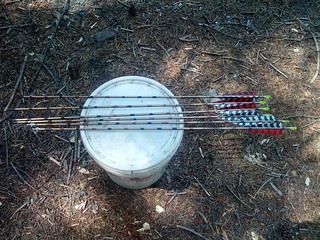
Well, to get that you have to get custom made arrows. Most shooters and thus most archery shops are targetting compound hunters. Usually these are hunters who shoot compound just so they can hunt in the archery season in addition to the gun season. Because of this they tend to shoot with all the fancy wizbang stuff, and with extremely heavy draw-weights (taking advantage of the let-off of a compound)... thus requiring extremely stiff arrows. As a result there are few arrows or shafts available below 1917 or so. Additionally it means most shops tend to sell you too stiff an arrow because it's based on poundage - but a recurve or longbow doesn't have as efficient of delivery of that force into the arrow (even more so for self-bows and such), so you'll generally need a softer spine for the same poundage.
What I found though was a shop that sold me 1716 aluminumarrow shafts. They also had feather fletching, 125 grain tips (a little light, but it'll do), knocks, and glue. Sadly they don't sell B50 (bow-string), but it seems no-one does you have to order it if you want it.
Well, I could pay them a bunch of money and wait for them to build the arrows, or I could do it myself. You can probably guess by the title of this post, and by the rest of the blog, what I did.
So, a few tips:
Start with the inserts
The arrow shafts aren't absolutely perfect, so before you start take a round file, stick it in the end of the arrow-shaft and spin it a little. This cleans out burrs that wil stop the insert from going all of the way in

Put a touch of glue on the insert, it doesn't take much, and then push the insert into the arrow shaft
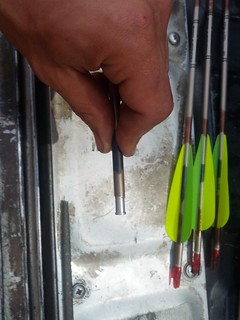
Put it in relatively quickly, have a flat surface handy and push HARD to make sure you get it all of the way in. If you're wondering about that picture, some of the arrow shafts I got were plastic fletched. I'll just strip the plastic off when I get around to fletching those (I only did 6 so far).
fletch
This is the fun part. You can use a jig and stuff, but chances are you don't have one (I didn't). Take a piece of paper and wrap it around the arrow shaft, starting at the end, Where it crosses itself mark the paper.
Measure the paper and divide in thirds (assuming you're doing a triple-fletch), mark this or another piece of paper with those increments, include all 3 so you can be sure you have the paper wrapped tight around the shaft when you're marking.
Figure out how far from the knock you want your fletching, something like 1.5"'ish... it's your choice really. Measure down and make a little mark you can see on the arrow. Here, use the paper you just made to mark 3 spots around the shaft. This will get your spacing right
To glue on the fletching. Put glue fairly sparsely on the fletching. Start at the *back* (the wide part) of the fletching and work towards the front. This is important so the glue dries in that order. Place the back on the arrow in the right place, don't try to hold the whole thing on as it won't work, just an inch or two worth. Hold in place for 20-25 seconds, this is enough for the glue to pretty much set. Now take the front and place it where it needs to be, and hold again for 20-25 seconds.
Move on to your next fletch
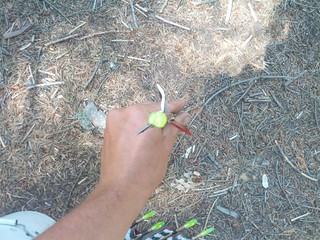
Then install the knock
The only reason I suggest doing it last is that then you don't have to think about it when you're fletching. You'll note from the photos that I did it in the wrong order. Take your key-feather (the one that's a different color) and place the knock so the key feather points wherever it is you want it to point. For me I like my key-feather to point away from the bow, this seems to work well for shooting off the shelf. There's no trick to this at all, just put some glue there, and shove the knock on... done.
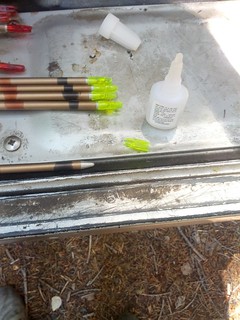
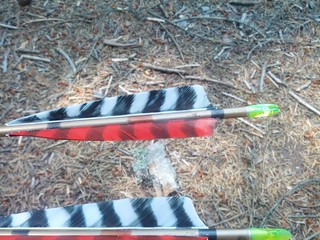
A little trick
To keep your arrow-tips from unscrewing, rub the threads in wax before screwing them in.
That's it!
You have a set of arrows. It really is incredibly easy. Personally I don't rifle my fletching, I've found that I don't care much and It's definitely quiter to straight-fletch, other's will disagree. If you want to rifle the jig becomes a lot more critical. Doing a straight-fletch I was surprised at how straight I could get the fletching.
Eventually I'd like to make arrows from scratch (along with a lot of other things), but it's always nice to have made what I use. It means I know it, understand it, and can make exactly what I want or need. It also means that I am more likely to be able to repair it. For archery: I made my quiver with commercial leather. A friend made my string with commercial material. And now I made my arrows with commercial parts.

